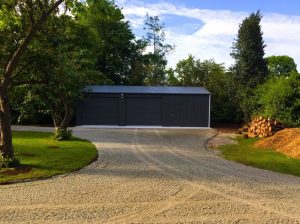Even if you’re a global warming skeptic, you’d have to agree we seem to be having more extreme weather events. There are drier periods followed by excessive rain. Vicious, damaging storms, horrendous heatwaves, extensive droughts. These extremes have the potential to ravage your yard.
The excessive dry periods – typically accompanied by heat – weaken the root structure of everything from grass to trees. Any new root growth tends to be close to the surface to try to capture every drop of moisture before it evaporates.
Heavy rain hitting bare or sparsely covered ground then has the potential to scour your soil, carrying it into gutters, drains, creeks, rivers and, eventually, the ocean.

The result is a downward spiral where each successive cycle leaves you with a yard that is harder to manage and a malnourished garden. So let’s get started on a course of prevention…
What is storm runoff?
It’s any natural precipitation – rain, snow and even hail, that doesn’t soak into the ground when and where it falls. When rain hits the hard, impervious surfaces associated with our modern lifestyles and homes – driveways, paths, streets, rooftops, parking lots –it’s channeled toward stormwater drainage systems. In many communities, these drainage systems empty into natural waterways.
Why is stormwater runoff a problem?
- Large volumes such as those associated with many recent weather events, can overwhelm storm drains and cause localized flooding.
- Runoff gathers both sediment and pollutants (for example, rubbish and fertilzers), which can wind up in natural waterways.
- Water that doesn’t soak into soil can’t recharge local groundwater sources.
The goal of managing stormwater runoff includes:
- Decreasing the volume and speed of water flow
- Minimizing the pollutants reaching our watercourses.
The goal of stormwater management is simple: slow it down, spread it out, soak it in.
Here are 11 affordable, easy to do solutions to stop or slow stormwater runoff:
Easy stormwater management tips:
1. Add plants.
Incorporate plantings, especially in areas where runoff collects. As water run off soaks into soil, plant roots help to absorb and filter out pollutants. When runoff soaks into and percolates through soil, the soil also acts as a filter, removing some pollutants.
2. Protect trees
Like other plant roots, tree roots help absorb and filter runoff. Tree canopies also slow rainfall and spread it over a larger area.
3. Break up slabs. Replace concrete patio slabs with pavers, flagstones, or bricks that allow water to soak in between items. For driveways, consider using turf block or leaving a strip of grass up the center.
4. Go permeable
Choose a permeable material for a path, patio, or driveway. Less expensive options include aggregate base, gravel, mulch, or crushed shells. Pricier options include pervious concrete or asphalt.
5. Catch runoff
Install a water tank to catch stormwater runoff from roofs. You can then save money by using this captured water on your garden when it needs a drink.
6. How to Divert Water Runoff from Driveway
Dig a trench. Use a shallow, gravel-filled trench to catch and slow runoff, especially at the base of a slope or alongside a driveway or patio. For slopes, consider creating a dry creek to catch, slow down and direct runoff, perhaps to a rain garden (see below).
7. Plant a rain garden
A rain garden is designed to catch and slow runoff. It’s frequently planted in low areas, at the base of a slope, or near downspout outlets. The design includes soil layers, mulch, and plants, all of which filter rainwater as it seeps into soil. Check with your local Cooperative Extension System office to learn rain garden basics.
8. Cover soil
Depending on the type, bare soil can be like concrete in terms of its ability to absorb water. Cover bare soil with mulch or a ground cover to slow stormwater runoff.
9. Swap your lawn for indigenous grasses and plants
Trade that high-maintenance turf for indigenous plants. Natives have adapted over millennia to your local growing conditions. They need less of everything – water, fertilizers and your time than lawns do! Because native plants tend to be deep-rooted, they tend to be very resilient to heat, drought and flood.

10. Drive on the grass
If your driveway isn’t permeable, wash your car on the lawn so water can soak into soil, instead of running into the street. This will not only stop pollutants from reaching the local waterways, it will promote a healthier, stronger lawn.
11. Use Swales to slow the flow
While swales are typically associated with farming, they are every bit as effective in a home setting. A swale is simply a long channel that cuts across a slope.
A swale does three things:
a) It slows the flow of water by creating an obstacle
b) It gives the water a chance to soak in because the water ‘sits’ behind the swale
c) It can be used to redirect the water to a pond or other location
A domestic swale may only need to be a few inches high to be effective. But a little imagination can turn a swale into something as stunning as this ‘dry creek bed garden’:

Wrapping it up…
There are many ways you can prevent stormwater damage. All of them will save you time and money in th long haul. But no matter what options you choose, always direct runoff away from your home’s foundations.
If your property has a steep slope or receives additional runoff from neighbouring properties, it may pay to consult with a professional landscaper to discuss possible solutions.
Ready to get started?






